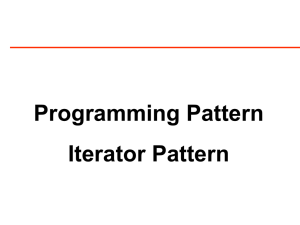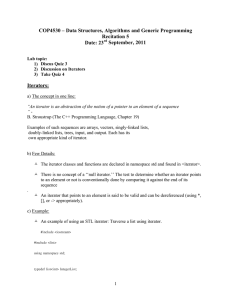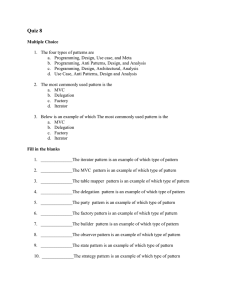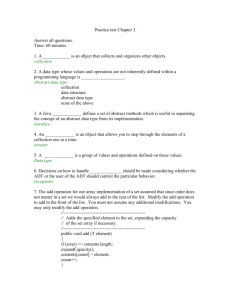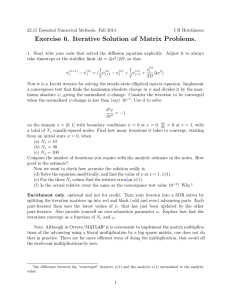Mid-Level Design Pattern: Iterator (chap. 16)
advertisement
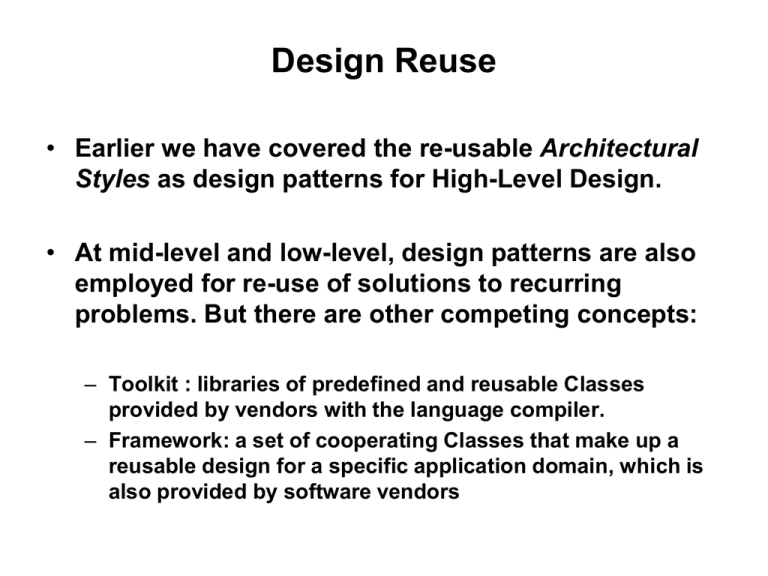
Design Reuse • Earlier we have covered the re-usable Architectural Styles as design patterns for High-Level Design. • At mid-level and low-level, design patterns are also employed for re-use of solutions to recurring problems. But there are other competing concepts: – Toolkit : libraries of predefined and reusable Classes provided by vendors with the language compiler. – Framework: a set of cooperating Classes that make up a reusable design for a specific application domain, which is also provided by software vendors Toolkits and Frameworks • Toolkits are libraries of Classes: – Each class is at the code level - - - “code re-use” – Each Class is “independent” of another Class – Each Class may be used more universally across different domains – Not really appropriate for mid-level design reuse, but more appropriate for very low-level design re-use. • Framework is a set of “cooperating” Classes: – Dictates a design and the over-all structure of your solution – It captures the design decisions common to an application domain and is for “design re-use” – Different framework may be needed for different application domain – A user of frameworks reuse the design, and focuses on the details of the specific application 1. When using toolkit, one design the main body of the application and employ (re-use) the specific Classes in the toolkit 2. When using a framework, one employ (re-use) the main body of the application and code the specifics Mid-Level Design Patterns • Mid-level design patterns are: – More abstract than framework or toolkit in that only “examples of code” may be provided in patterns – Smaller design element than framework – Less domain specific than framework – Sometimes “implemented” in current language such as Java standard Class library • There are many mid-level design patterns and different ways to classify them: – (Gamma, et al) by purpose: • Creational: deals with the problem of object creation • Structural: deals with composition of Classes • Behavioral: deals with Class and object interactions and distribution of responsibilities – (Fox) by form and problems they solve: • Broker: mediates between the client and the supplier of services • Generator: provides instances of Classes to the client • Reactor: provides solutions to event driven problems Example of Broker Pattern • A Broker pattern mediates between the client and the supplier classes. – A Client requests a Supplier service from the Broker, which will interact with the Supplier to obtain the service on behalf of the Client • We will consider an Iterator Pattern in detail client Broker supplier Problem: Iterating over a “Collection” of items array tree set Seems Simple - - • What’s wrong with using the “for --- loop” construct which exist in most programming language? • Nothing - - - but can it work for all types of “Collections?” - - - - are there structures that would be difficult to deal with? • Should the iterator design be influenced by the collection’s structure? Some Desirable General Characteristics 1. 2. 3. 4. Information hiding: do not expose the internal structure of the collection Multiple simultaneous iterations: capable of iterating over the same collection with multiple iterations at the same time. Simple Interface: the interface to the collection must not be cluttered. Flexibility: there must be flexibility in processing during the iteration processing (e.g. tolerate changes to the collection while iterating through the collection) Where do we start in designing this? • What’s needed to iterate through a collection? – Initialize: prepare to start iterating and accessing the elements of the collection – Access: provide access to the “current” element in the collection – Advance: move to the “next” element in the collection – Completion Test: indicate if all the elements in the collection have been visited. • Are there any other concerns? – Revert: go back to the previous element – Skip: visit only those that has certain characteristics Design Choices • Control: – External: the client controls the iteration mechanism and the iteration mechanism provides the elements from the collection to the client, as directed by the client. – Internal: the iteration mechanism accepts operations from the client and applies to the elements of the collection with out the client control over the iteration mechanism • Residence: – Within the Collection: the collection includes the iteration mechanism – Separate Iterator: a separate Iterator houses the iteration mechanism Built with-in the Collection • Internal Control: – Can easily hide the collection structure since the iterator mechanism is part of the collection - - - - BUT – Can not easily perform simultaneous iterations because the each individual iterator can not be easily separated out . – Lacks flexibility such as stopping the iteration half way because there is no client control • External Control: – Can easily hide the collection structure by only exposing the control interface ( initialize, access, etc.) – Can be flexible by adding more iteration control functions - - BUT – But the Collection interface may be complex as more iteration control functions are added – Can not support multiple simultaneous iterations because we can not provide such an interface Putting the iteration mechanism, with internal or external control, within the Collection is NOT a good idea because some of the “desirable” characteristics can not be met. Build in Separate Iterators • If the iteration mechanism is placed in a separate Iterator, two of the previous problems are solved: – Multiple simultanous iterations may be implemented by using separate iterators – Collection interface will remain simple even if more functionalities are placed into the iterator - - - absorbs the complexity • The iterator must ensure that the internals of the collection is not exposed to anyone but only to the iterator itself. • Iterator with internal control has the drawback of not being flexible (in terms of client demands for altering iteration) Thus, the “best” choice for a general design for iteration mechanism is to have extrnal-control-separate-Iterator Iterator Design Pattern Structure << interface>> Iterator << interface>> Collection initialize( ) getCurrent( ) next( ) complete( ) concrete_Iterator * 1 concrete_Collection Note that we are using interfaces, and each collection of items may have more than one Iterator Iterator Design Pattern Behavior concrete_Collection Client i = Iterator( ) concrete_Iterator initialize( ) done= complete( ) loop [! Done] e = getCurrent( ) next( ) done = complete( ) X create Implementation Considerations • Some language may already have implemented the Iterator - - - e.g. JAVA has an Iterator interface defined as part of the class library for iterating through a Collection of objects, one object at a time. • If one is to implement the Iterator pattern, make sure that the Collection’s internal structure is not exposed. – One way is to include the Iterator Class as an inner Class of the Collection Class – The crucial attributes of the Collection may be passed to the Iterator via reference or via alias, allowing the Iterator to access the internals of the Collection. Pattern Description • A pattern has 4 essential elements: – Pattern Name : the short name – Problem Description: Iteration mechanism for arbitrary Collection of items – The Solution: the various choices and the final selection of the solution – Consequences: trade-offs of applying the pattern and possible implementation considerations
